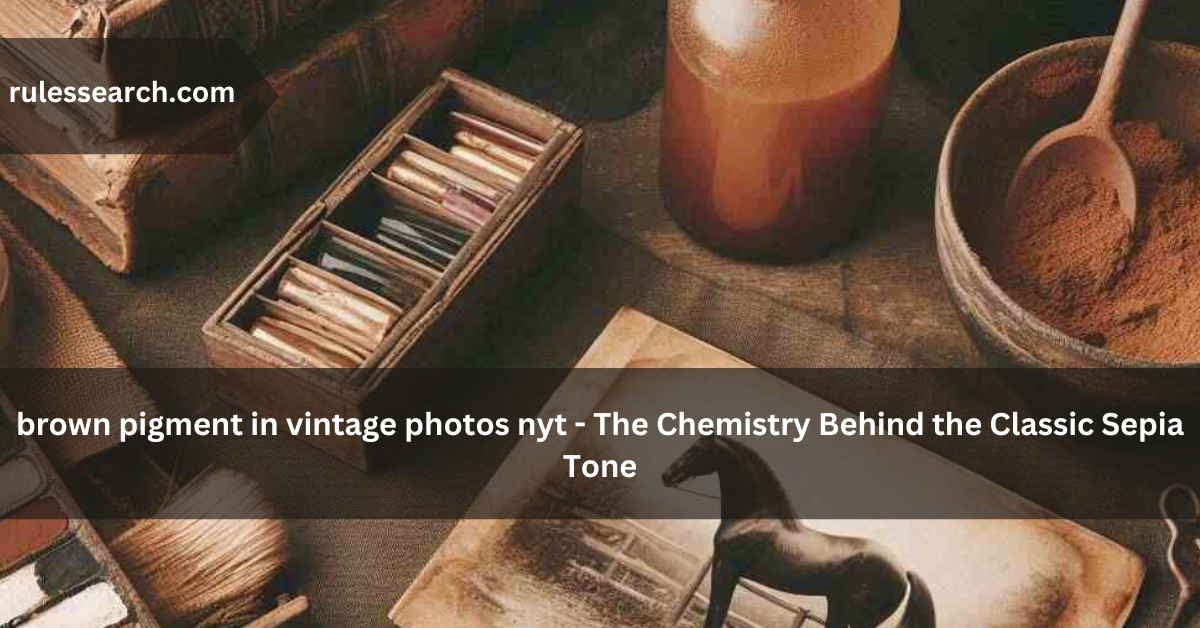Introduction
Vintage photography holds a special allure, particularly in the USA, where sepia-toned photographs often evoke a deep sense of nostalgia. These images, with their distinctive brown pigment, tell stories that span generations, capturing moments in history, culture, and personal memory. But what gives these vintage photos their characteristic brown hue? The answer lies in the chemistry of photographic processing and the deliberate use of specific pigments to achieve this classic aesthetic.
The Chemistry Behind brown pigment in vintage photos nyt
The warm brown pigment seen in many vintage photographs is largely due to a photographic technique known as “sepia toning.” Sepia toning is a method where the metallic silver in traditional black-and-white photographs is replaced with silver sulfide, a compound known for its stability and resistance to environmental degradation. This technique not only imparts the familiar brown tone but also enhances the photograph’s durability, making it more likely to withstand the test of time.
How Sepia Toning Produces brown pigment in vintage photos nyt
The process of sepia toning begins with a standard black-and-white photograph. During the development process, the image undergoes a bleaching phase, which converts the silver present in the photograph into silver halide. The photograph is then immersed in a sepia toning bath, where the silver halide is replaced with silver sulfide. This chemical transformation is what gives the photograph its signature brown pigment, creating the timeless look associated with vintage photos.
The Historical Significance of brown pigment in vintage photos nyt
Sepia toning, and the resulting brown pigment, was not just an aesthetic choice for photographers in the 19th and early 20th centuries. It was also a practical decision aimed at preserving the longevity of photographs. The stability of silver sulfide compared to pure silver made it a preferred medium for photographers concerned with the durability of their work. As a result, many historical photographs, especially those from the late 1800s and early 1900s, have survived in remarkable condition, thanks in large part to the protective properties of the brown pigment produced through sepia toning.
Preservation Through Sepia Toning
Photographs are susceptible to various forms of degradation over time, including fading due to exposure to light, humidity, and pollutants. The use of silver sulfide in sepia toning provided a solution to this problem. The compound’s stability means that sepia-toned photographs, with their distinctive brown pigment, are less likely to fade or discolor over time. This quality has made sepia-toned images valuable not only as historical artifacts but also as enduring works of art.
The Continuing Appeal of brown pigment in vintage photos nyt
In today’s digital age, sepia toning is often employed for its aesthetic appeal rather than for preservation. Photographers and graphic designers can easily apply sepia tones to images using digital tools, creating the characteristic brown pigment with just a few clicks. Despite the convenience of modern technology, some photographers continue to use the traditional chemical process, appreciating the authenticity and unique texture it imparts to images.
brown pigment in vintage photos nyt in Contemporary Photography
In recent years, there has been a resurgence of interest in vintage aesthetics, including the use of sepia tones. This trend is evident in various forms of media, from wedding photography to social media filters. The warm, nostalgic feel of sepia-toned images appeals to those who appreciate the timeless quality of vintage photography. The brown pigment in these photos not only harks back to a bygone era but also adds a sense of warmth and depth to contemporary images.
The Artistic and Emotional Impact of brown pigment in vintage photos nyt
Beyond its technical aspects, sepia toning—and the resulting brown pigment—has a profound artistic and emotional impact. The warm brown tones can evoke feelings of nostalgia, warmth, and comfort. This is why sepia-toned images are often used in contexts where a connection to the past or a sense of timelessness is desired. The emotional resonance of these images is one of the reasons why the brown pigment remains popular, even in an era dominated by color photography.
The Emotional Resonance of brown pigment in vintage photos nyt in Sepia-Toned Images
Sepia-toned photographs have a unique way of bridging the past and present. The brown pigment can make modern images appear older, creating a sense of continuity between generations. This emotional resonance is one of the reasons why sepia toning remains popular, even as photography technology evolves. The warmth and depth of the brown pigment in these images can evoke powerful memories and emotions, making them cherished keepsakes for many.
Common Misconceptions About brown pigment in vintage photos nyt
Despite its popularity, there are several misconceptions about sepia toning and the brown pigment in vintage photos nyt. One common myth is that all old photographs were sepia-toned. In reality, sepia toning was just one of several techniques used to preserve and enhance photographs. Not all vintage photos have a brown hue; some were purely black and white, while others were hand-colored.
Debunking Myths About Sepia Toning and brown pigment in vintage photos nyt
Another misconception is that sepia toning was primarily used for artistic reasons. While the warm brown tones do add an artistic touch, the primary motivation behind sepia toning was the preservation of the photograph. Understanding this context helps us appreciate the technique not just for its aesthetic value but also for its role in the history of photography. The brown pigment, therefore, is not just a visual choice but a marker of the photograph’s durability and historical significance.
A Step-by-Step Guide to Sepia Toning
For those interested in experimenting with sepia toning and creating that classic brown pigment, both traditional and digital methods are available. Here is a step-by-step guide for achieving sepia tones using both approaches:
The Classic brown pigment in vintage photos nyt Process
- Start with a Black-and-White Photo: Begin with a developed black-and-white photograph.
- Bleaching: Immerse the photo in a bleaching solution to convert the silver to silver halide.
- Sepia Bath: Place the bleached photo in a sepia toning bath, where the silver halide will be replaced by silver sulfide, resulting in the desired brown pigment.
- Rinse and Dry: Rinse the photograph thoroughly to remove any excess chemicals and allow it to dry, revealing the rich brown tones.
Achieving brown pigment in vintage photos nyt with Modern Tools
- Open Your Image in Editing Software: Use software like Adobe Photoshop or Lightroom.
- Convert to Black-and-White: Start by converting the image to black-and-white to establish a base for the brown pigment.
- Apply Sepia Tone: Use the software’s sepia toning filter or manually adjust the color balance to introduce brown tones.
- Adjust Contrast and Brightness: Fine-tune the image to achieve the desired vintage effect, emphasizing the warmth of the brown pigment.
The Future of Sepia Toning
As photography continues to evolve, the future of sepia toning—and the creation of brown pigment in vintage photos—lies in its ability to balance tradition with technology. While digital tools make it easier than ever to achieve a sepia effect, the traditional chemical process still holds a place for those who value the craft of photography. The enduring appeal of sepia-toned photographs demonstrates the timeless nature of this technique and the continued relevance of the brown pigment in both historical and contemporary contexts.
The Enduring Legacy of brown pigment in vintage photos nyt
The enduring appeal of sepia-toned photographs, with their warm brown pigment, showcases the timeless nature of this technique. Whether used for preservation, artistic expression, or emotional impact, sepia toning remains a beloved aspect of photographic history. The brown pigment in vintage photos is not just a visual element; it is a testament to the enduring power of photography to capture and preserve memories across generations.
Conclusion
Sepia toning is more than just a method to give photographs an aged look; it is a technique with deep historical roots and significant artistic value. Understanding the chemistry, history, and emotional impact of sepia toning and the brown pigment it produces allows us to appreciate this technique in a new light. Whether you are a photographer, historian, or simply a lover of vintage aesthetics, the brown pigment in vintage photos nyt offers a unique window into the past, bridging the gap between history and the present.
FAQs About brown pigment in vintage photos nyt
What is sepia toning?
Sepia toning is a photographic technique that replaces the metallic silver in black-and-white photos with silver sulfide, resulting in the images’ warm brown pigment.
Why were vintage photos often sepia-toned?
Sepia toning was primarily used for its preservation benefits, as silver sulfide is more stable and less prone to fading than pure silver, leading to the characteristic brown pigment.
Can I create sepia-toned photos digitally?
Yes, digital photo editing software like Adobe Photoshop allows you to apply sepia tones and achieve the desired brown pigment with ease.
Is sepia toning still used today?
While not as common as in the past, sepia toning is still used both in traditional darkroom processes and digitally for its aesthetic appeal and the creation of brown pigment.
How does sepia toning affect the longevity of a photograph?
Sepia-toned photos tend to last longer than non-toned black-and-white photos because silver sulfide, which produces the brown pigment, is more resistant to environmental factors.
Were all old photographs sepia-toned?
No, not all old photographs were sepia-toned. Some were purely black-and-white, while others may have been hand-colored or used different toning techniques.
What gives sepia-toned photos their brown color?
The brown pigment in sepia-toned photos comes from silver sulfide, which replaces the silver in the original black-and-white photograph.
Can I convert a color photo to sepia?
Yes, you can convert a color photo to sepia using digital editing tools, which will apply a brown pigment to create a vintage look.
Is sepia toning an expensive process?
Traditionally, sepia toning involved additional chemicals and steps, making it more costly than standard black-and-white processing. However, digital sepia toning is cost-effective.
What are the artistic advantages of sepia toning?
Sepia toning adds warmth, depth, and a sense of nostalgia to images, making the brown pigment a popular choice for creating timeless and emotionally resonant photographs.


